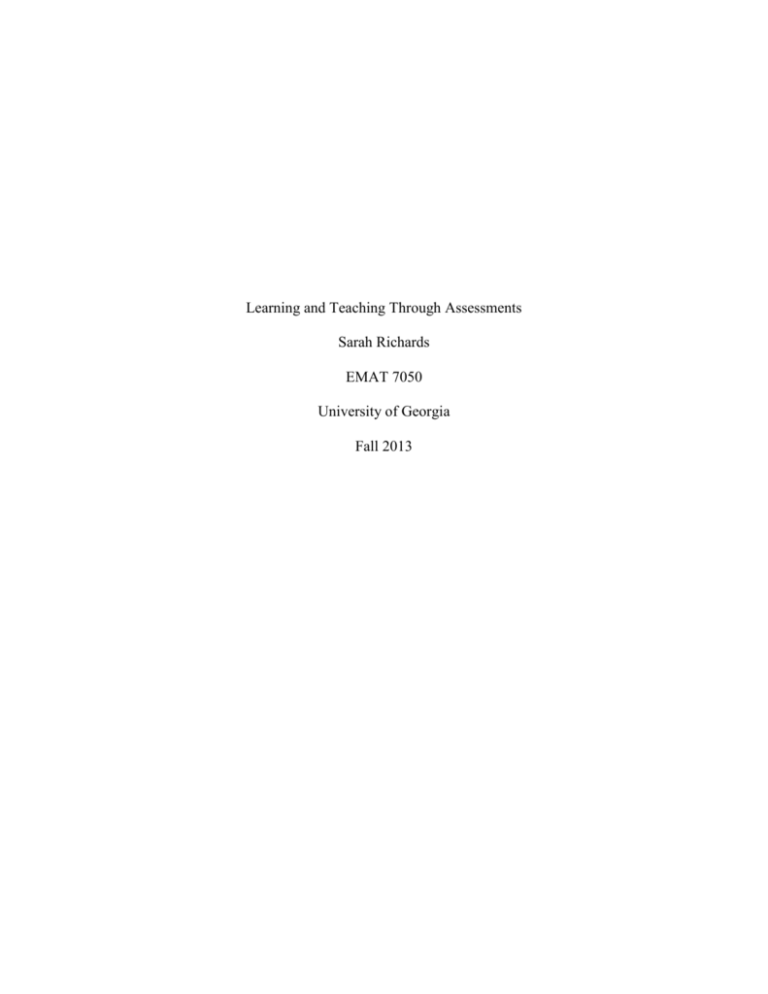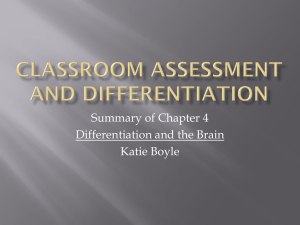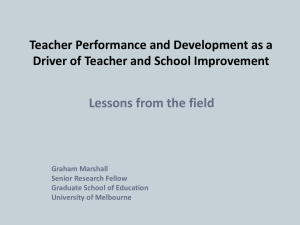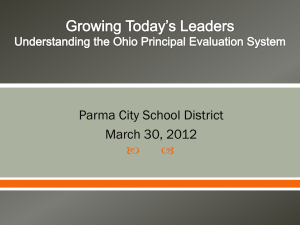Learning and Teaching Through Assessments
advertisement

Learning and Teaching Through Assessments Sarah Richards EMAT 7050 University of Georgia Fall 2013 Richards 2 Learning and Teaching Through Assessments Teaching and learning must be interactive and influential between one another. Teachers need to know what their students understand and/or struggle with understanding so that they can make changes in their instruction that can immediately address these situations and gear students back on the right path. Perhaps, this is just one of the many jobs teachers are responsible for during a regular school day. Learning is possible only when teachers and students become interactive with new knowledge. Each year, states and school districts adjust their learning standards in order to continue to challenge students and raise the bar for success. Of course, formulating and implementing a more rigorous curriculum can only be possible if teachers can balance their current duties while tackling new tasks more effectively. With the newest common core standards that were recently introduced in schools, it is imperative that teachers monitor students’ progress throughout each unit. We want our students to achieve a high level of understanding and be able to retain this new knowledge. How should teachers assess? When is it the right time to formally assess students? These are questions that formulate the purpose of this article review. Everything that teachers provide for their students should have a distinct principle and raise the belief that whatever it may be, it is important. In this synthesis, the following is discussed: 1. History of assessments in America’s education 2. The role of assessment in classrooms 3. Different ways of assessing students: Formative assessments, summative assessments, alternative assessment: portfolios Richards 3 Once teachers can gage a foundational understanding of these common assessments that are evident in many classrooms, the results from the assessments can alter plans so that lessons better accommodate students’ understanding of the content. Assessment has been a part of America’s educational system for many years. Some of the early research focuses on aptitude tests. According to Merriam-Webster dictionary, aptitude is having the ability to do something or to learn something. Therefore, as cognitive theory developed through the 1960’s, a transition occurred. This transition moved from cognitive theory towards intelligence and aptitude test performances. Later, this appeared to then converge into more studies on individual differences in the context of specific instruction or learning domains. This time lapse covered the major educational research time period from 1957 to roughly 1990 (Pellegrino, 1999, p.8). In the early 1990’s, a major attempt to bring theories of cognition together with curriculum and assessment was to use assessments as the vehicle to promote instructional change. The idea was that changes in tests would drive changes in instruction (Pellegrino, 1999, p.8). As a common preparation, teachers will focus on important cognitive performances prior to administering a test. In return, students will gain a better cognitive understanding for the subject matter. Assessment is ever-changing as research concludes better ways of using and analyzing results. Therefore, there are many reasons why particular assessments are not acceptable for concluding student achievement. For instance, at different stages in the learning process, there exist different levels of knowledge, skills, and performance abilities among students. Teachers can take observations of individual students and whole group and conclude the best design for a given assessment. Richards 4 “Worthy assessments should reflect the broader capabilities that students need to thrive in the 21st century” (Sternberg, 2008, 20). Robert Sternberg, psychologist, states that many qualities and characteristics are needed to be successful in the real world, and none of the ones he stated are ever assessed in schools. For example, people should obtain personal attributes and characteristics such as creativity, common sense, dedication, honesty, team work, and others mentioned that will help a person be successful. Rather, much of what teachers assess are facts and items that are straight from a textbook. Think back to college or high school years. Do you remember a time that you nearly pulled an all-nighter just to pass a test, then days later forgot everything that you studied simply because it did not apply to your life or future career? Often times, assessments teachers administer to students are similar to just that. Within Sternberg’s article, “Assessing What Matters,” he mentions two models that capture the essence of creating assessments that incorporates the underlying citizenship and leadership skills that all individuals should possess. The first model mentioned is WICS which stands for wisdom, intelligence, creativity, and synthesized. The idea for this model is to include those characteristics that are important for individuals to possess. “An active and engaged citizenship and leadership requires individuals to have (1) a creative vision for how they make the world a better place, not just for themselves but also for others; (2) the analytical intellectual skills to be able to explain why their vision is a good one; (3) the practical intellectual skills to be able to execute their vision and persuade others of its value; and (4) the wisdom to ensure that their ideas represent a common good, not just their own interest” (Sternberg, 2008, 22). The four distinguishable attributes incorporated in this model are personal qualities that students should obtain. Richards 5 The second model mentioned actually was developed before WICS to determine if it was possible to teach and assess students based on analytical, creative, and practical achievement. Notice that wisdom is not yet established as something different than practical skills; therefore, in the later model, wisdom is more exclusive in terms of assessment. This model of successful intelligence can easily be valuable cross-curricular. Provided in the article are examples of how the model can be significant when assessing students. “In mathematics, we might ask (1) what is the interest after six months on a loan of $4,000 at 4 percent annually (analytical)? (2) Create a mathematical problem involving interest of a loan (creative). (3) How would you invest $4,000 to maximize your rate of return without risking more than 10 percent of the principal (practical)? (4) Why do states set maximum rates of interest that lenders can charge, and should they do so (wisdom)” (Sternberg, 2008, 23)? This example includes wisdom as a fourth domain. This model of assessment provides ways of asking students to answer a logical question or task in such a way that formulates their work into different cognitive domains. Teachers can then evaluate students’ understanding and progress with the mathematical content. The role of assessments in America has drastically changed since the early 1990’s. Measurement and evaluation are indispensible aspects of mathematics teaching in regards to students’ success. Assessments should be a collection of evidence about students’ mathematical skills and knowledge in order to find out more about students understanding in regards to the content. Two classifications of assessments include formative and summative assessments. Formative assessments ultimately are useful in providing immediate feedback to both the teacher and students regarding the learning and teaching processes. Summative assessments help determine if the learning and teaching goals have been met. Also known as assessment of Richards 6 learning, summative assessments usually appear at the end of a unit or school year. Both types of assessment are useful in determining and evaluating student achievement. Formative assessments can be valuable if the tools to formatively assess are of quality and if the results are used to improve instruction. Utilizing this kind of assessment involves teachers critically analyzing students’ learning from a collection of information, making corresponding adjustments to the instruction and delivery of content, and continuing to collect information on student data (Johnson and Jenkins, 2009). According to Stiggins and DuFour, formative classroom assessments must be continuous while the learning is happening. This continuous tracking of each student’s journey will support students as they master progressive levels of prerequisite learning (Stiggins and DuFour, 2009, p.640). It is important to point out that although research states that formative assessments can track what level of understanding each individual is at during the time it is given, assessments do not need to be completely unique for every individual. Some teachers may already have a common idea of formative assessments that are active in the classroom. Whatever it may be, if teachers are using any kind of feedback from the formative task to modify instruction, then the task is most likely some level of formative assessment. According to the Council of Chief State School Officers’ (CCSSO), the following five attributes make formative assessments affective in the classroom: learning progressions articulating the lesson’s goals, learning goals and criteria are clearly identified, descriptive feedback linked to intended instructional outcomes, self and peer assessments which provides the opportunity to think meta-cognitively, and collaboration between teachers and students (Wylie, 2008, p. 3). Richards 7 Included below is an example of a formative assessment that was carried out in a middle school mathematics classroom. Throughout this description of the particular classroom, consider the effectiveness of how the teacher formally assesses her students and attempts to modify part of her instruction based on the feedback information she gathers. Of the list of attributes mentioned by CCSSO, this formative assessment aligns with collaboration and self- and peerassessment. After students have had the opportunity to self-assess their mathematics homework, they share with the class which particular mathematics problems they struggled with completing. Other students in the class have an opportunity to share their approach to the problem. It is apparent that this teacher created a positive environment for her students to feel confident and be a risktaker in order to share their solutions. While students began to offer answers, the Wylie, E.C. (2008). Formative assessments: examples of practice. Paper prepared for the FAST, SCASS, & CCSSO. teacher was able to identify those students who struggled with the content and also was able to recognize which kinds of problems stumped with students. The information Richards 8 collected through this experience was helpful as the teacher modified her initial lesson plans in order to better accommodate struggling students. Although this is not mentioned in the text, this kind of formative assessment approach can also be used as a means of identifying those students who are ready to move on to new material and show they have mastered the current standard. Unlike formative assessments, summative assessments are tools that determine what students have learned. The importance of summative assessments is the direct linkage among assessments, curriculum, and instruction. When these objectives clearly match, the results can reveal an accurate understanding of what each student knows and has learned. Although summative assessments are useful in tying up loose ends to a unit or grade level, they are often criticized by their disconnectedness to an entire content area (Johnson & Jenkins, 2009). Nonetheless, summative assessments can provide crucial information about students’ overall learning. The good ole state of Georgia has a state-wide mandated summative test that every student enrolled in particular grade levels is required to take. This assessment is the CriterionReferenced Competency Test (CRCT). This test is designed to measure the skills and knowledge students gain while enrolled in a class studying under the state-mandated content. The use of this assessment is to recognize students’ strength and weaknesses about the content and also gather information about the quality of instruction in Georgia. However, like other summative assessments, the results have little effect in modifying instruction of the class and lack any potential improvements for student behavior and progress in the class. Usually, this kind of summative assessment is given at the end of the school year in order to incorporate much of the content delivered throughout each grade level. Richards 9 Sometimes, teachers should think outside of the box and create alternative forms of assessment beyond what seems traditional. Utilizing a variety of assessments can benefit all mathematics classes. Learner characteristics drastically differ among any group of students. So, to only rely on one type of assessment will place many students who are plenty capable of demonstrating their knowledge and understanding through other methods in a disadvantage (Watt, 2005, p. 23). Alternative assessments should address a wide range of learner styles so that all students feel confident and able to communicate their understanding. Alternative assessments consist of many different kinds, but one of the most popular is having students create a portfolio. A portfolio can have different purposes and can be evaluated under different expectations too. For example, if a student is going to be graded based on their work, then that student might only include those items that are the greatest final version of each assignment. Or, some portfolios could be used to reveal the total work students have put forth toward each assignment. In this case, the portfolio would include different types of assignments such as rough drafts to final copies. And, sometimes the task of completing a portfolio is to remember what tasks have been accomplished. For this, students would normally include those assignments that are personal favorites or a keepsake. In any case, encouraging students to make a portfolio can be a successful tool in establishing students’ progress in mathematics. When creating a portfolio, students are essentially choosing which assignments they want to include in the product. Writing a self-reflection, students can develop a rationale as to why they chose to incorporated particular assignments into their portfolio. Judith Arter and Vicki Spandel stated that recording this self-reflection in the form of a “metacognitive” letter not only documents this type of student performance but also encourages it (1992, p. 37). Criteria also Richards 10 provide a schema for thinking about student performance. Having supportive and clear criteria helps set the instructional goals and expectations throughout the evaluation process. Although this form of alternative assessment is creative and a process which is continued overtime, criteria sets forth a systematic, organized way for students to follow through directions using their inspired, exploratory minds to show their greatest achievements and efforts throughout the school year. Incorporating portfolios as an alternative assessment might seem like a large amount of work placed on the teacher and students. The teacher will need to design the portfolio system so that all the work involved in making a final portfolio is a good representation of what students know and can do, the criteria used to analyze the final product reflects the purpose of the task, and the work that students put into building a portfolio is worth the extra time and effort. “For example, if students only do computational worksheets in mathematics, work samples might not be available that shows mathematics problem-solving availability” (Arter & Spandel, 1992, p. 38). Therefore, the final product should include a multitude of tasks and formats that grasps the possibilities for a student to demonstrate their understanding and knowledge. A previous study focused on teacher’s attitudes about alternative assessments. Concluded in this study, researchers found that many teachers do not willingly want to implement alternative assessments in their classrooms. The results showed that teachers were satisfied with traditional ways of assessing students to measure their ability. Teachers did, however, state some common concerns with implementing alternative assessments. The results of this study provided major reasons mathematics teachers hesitate using alternative assessments in their classes. Some of the reasons were the following: insufficient time for implementation, unsuitable, or insufficient resources at hand (Watt, 2005, p. 30). Richards 11 It is essential to monitor students’ progress as they learn and grow in school. Therefore, teachers must utilize new assessments that can assist pinpointing where students are, where they need to go, and suggesting ways of getting there (Lai, 2013). New standards are being implemented in schools that promote high order thinking skills and response tasks that students will most likely see in college and their career fields later in life. Rather than continuing to assess students with multiple choice tests, students will have to derive information from literacy, informational text, and data to formulate an argument and solve problems. This is a work in progress. But, in order for these kinds of assessments to become the norm, our country needs fierce teachers who are willing to change their “old school” habits of traditional assessment to more rigorous, focused assessments that modifies the following lesson according to the overall progress of student learning. Richards 12 References Aptitude [Def. 1]. In Merriam Webster Online, Retrieved November 11, 2013, from http://www.merriam-webster.com/dictionary/aptitude Arter, J. & Spandel, V. (1992). Using portfolios of student work in instruction and assessment. Educational Measurement: Issues and Practices, 11(1). 36-44. Johnson, E. & Jenkins, J. (2009, Dec 23). Formative and summative assessment. Retrieved from http://www.education.com/reference/article/formative-and-summative-assessment/ Lai, E. (2013, Oct 7). New standards and assessments raise the bar and boost competitiveness. Retrieved from http://researchnetwork.pearson.com/featured-blog/new-standards-andassessments-raise-bar-and-boost-competitiveness. Pellegrino, J. (1999). The evolution of educational assessment: considering the past and imagining the future. Policy evaluation and research center. 1-21. Sternberg, R. (2008). Assessing what matters. Educational Leadership,65(4). 20-26. Stiggins, R. & DuFour, R. (2009) Maximizing the power of formative assessments. Phi Delta Kappan, 90(9), 640-644. Watt, H. (2005). Attitudes to the use of alternative assessment methods in mathematics: a study with secondary mathematics teachers in Sydney, Australia. Educational studies in mathematics, 58(1) 21-44. Wylie, E.C. (2008). Formative assessment: examples of practice. Paper prepared for the Formative Assessment for Teachers and Students (FAST) State Collaborative on Assessment and Student Standards (SCASS) and The Council of Chief State School Officers (CCSSO).






